Mathematics and Computer Programming Work Together to Create
Contemporary Needlepoint Designs
by Stephen Mooney
These designs have a common motivation. I have always been intrigued by repeating patterns. Whether wall paper, wall tiles, or the bathroom floor, I would sometimes stare at the patterns or tiles with great concentration. Maybe it was like looking at a mandala. A form of meditation. I would try and create more complex designs out of the simple patterns present by imagining connections among the parts.
One way to create complex designs is to use recursion. Recursion is a method of extending a simple pattern by replacing some part of the original pattern with the entire original pattern, but drawn on a smaller scale. The new pattern made from this process still contains the original pattern, so the operation can be repeated again and again, each time yielding a more complex pattern.
One example of this is the picture in a picture. The picture is of an artist's studio with the artist painting a picture on an easel. The picture on the easel is the original picture. Another common example of recursion is to stand between two mirrors held parallel to each other. One sees in infinite number of reflections of oneself.
By its nature, recursion is infinite, and real pictures or designs can only show the recursion up to some limited point. But usually the mind's eye can look at the limited recursion and see the infinite pattern. This makes a good way to meditate.
I chose needlepoint for these projects for many reasons. I wanted to end up with pictures to hang on the wall to be viewed from across the room. I wanted durable construction that was low maintenance. I considered mosaic, but the amount of detail possible was low unless a very large project was undertaken. Making a mosaic out of small colored beads remains a possibility for future projects.
I was introduced to needlepoint by my mother, who had made many beautiful designs based on M.C. Escher's work. I tried an easy project, and found needlepoint very relaxing. The results looked good, even though I was a beginner.
Each of these projects took a year. I would typically design a new pattern during the holiday season. In February I would buy the yarn and canvas. Doing the actual stiching lasted from March thru November.
I studied mathematics and computer programming, so part of the fun I had was in constructing programs to create the designs, color them, and render them as needle point patterns. These designs are based on one of three different patterns: Pentominos, Fractals, or two forms of the Penrose tiling.
Pentominos
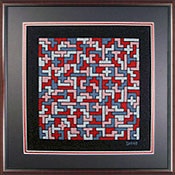
I was introduced to pentominoes by Arthur C. Clarke's book "Imperial Earth". Pentominoes are like dominoes, except five squares are used to make each piece. There are twelve different shapes that can be made from five squares. A set of these twelve shapes covers 12 times 5 or 60 squares in all. A puzzle is to fit a set of the twelve shapes into 6 by 10, 5 by 12, 4 by 15, or 3 by 10 frames. Such puzzles are actually commercially available.
I immediately saw these shapes as tiles for a bathroom floor, or a large rug. To cover large areas you need to use many sets of the twelve shapes. The easiest way is to fit them into the frames mentioned above, then arrange these rectangular frames into fill the area desired. However, if you do this, you immediately see the outlines of the frames. I wanted a pattern that would not easily reveal boring rectangles when I looked at it. I wanted to use an equal number of each shape. I wanted each shape evenly spread out.
The answer ? Recursion. Fit the twelve pieces into twelve frames each shaped like one of the pieces themselves. This project is one of many designs I made on this theme. The colors chosen match a couch in our living room.
I think this approach can be used best on large rugs. I hope one day to hook a large rug based on an even more intricate pattern of pentominoes.
Kites and Darts
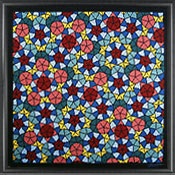
To one interested in tilings as I am, the January 1977 issue of "Scientific American" was a bombshell. I still have it ready at hand on my desk. Martin Gardner's column in this issue described Roger Penrose's tiles. These are commonly called "kites and darts" after their shapes. These tiles cover any area, but there is no large scale symmetry. As the article points out, there is a recursion rule that creates a larger (or smaller) tiling out of any given design. However, the rule hides the original pattern, so it is impossible to see the recursion rule just looking at the design.
I wanted an example of this to contemplate. This design is the result. The coloring emphasizes small symmetrical areas, as well as highlighting the non-symmetric connections between them. One can pick out larger symmetries, and is left imagining how these larger symmetries are connected.
Galaxy (Mandelbrot Set)
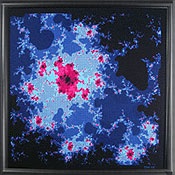
The book "The Fractal Geometry of Nature" by Benoit Mandelbrot introduced me to the beautiful patterns generated by fractals. Fractals are made up of a simple pattern, and a resursion rule to operate on the pattern. Strictly speaking, fractals are infinitely complex and provide many opportunities to ponder the mathematical subtleties of the infinite. However if you stop the recursion at some point, and choose a clever way to assign different colors to parts of the interrupted recursion, many beautiful designs appear. These are popularly known as Fractals.
Many computer programmers interested in graphics have written a fractal design generator for themselves. I spent months with mine, exploring the many depths of the "Mandelbrot Set" (A particular type of fractal named after the author of the book.)
I found this pattern in the Mandelbrot Set at a magnification of about 4,000,000 near the location (0.43, 0.22). It looks like an image of a far galaxy taken by a large telescope. You can see at least three levels of recursion in the design. The larger galaxy has many smaller satellite galaxies orbiting it. These smaller galaxies have their own satellites, etc.
Other parts of the Mandelbrot Set have an entirely different apperance. There are many beautiful designs here awaiting only time and effort.
Twisty Curvy Lines, all alike
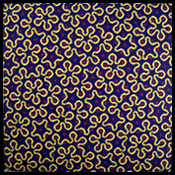
That bombshell article in Scientific American also described a way to draw a design on the kites and darts, but did not show what it would look like. I experimented with this for a while, and was able to see the recursion rule in the resulting patterns. I wanted to create as large a pattern as I could.
The recursion can be seen in this design, but it takes a lot of concentration. It is easy to loose one thread while following it. The very simple blue and gold coloring suggests to me a flag or banner.
Colored Twisty Curvy Lines
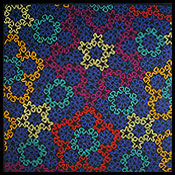
This design is essentially the same as the one above. The coloring scheme was chosen to emphasize the recursion.
The smaller patterns are grouped in several ways to form larger patterns. These larger patterns are grouped in the same ways to form yet larger and larger patterns. Each scale of grouping is surrounded by an outline made of a single continuous curvey line. This grouping continues on larger and larger scales without limit. Although symmetry can be found within the groupings at each scale, there is no overall large scale symmetry.
Meditation discovers many relationships among the smaller parts of the design. This design comes the closest yet to realizing my original goals for designing complex needlepoint patterns to meditate on.
Also: See and read about my recent more elaborate designs based on Pentominoes and Penrose tiling, completed since this article was published.

